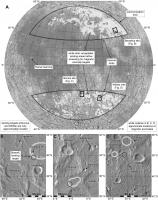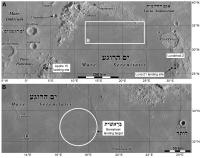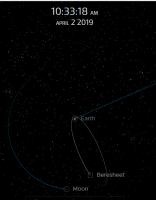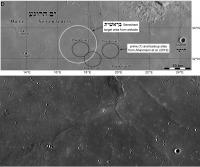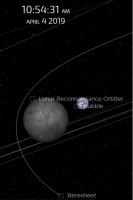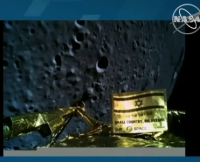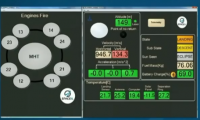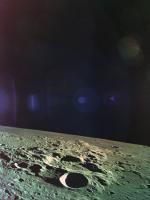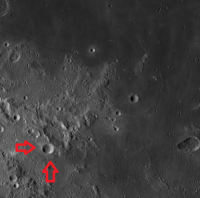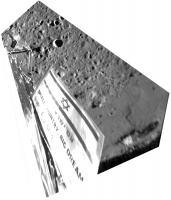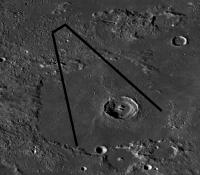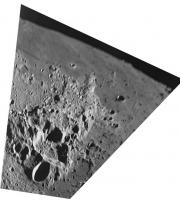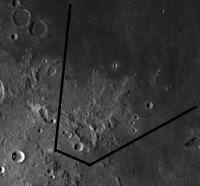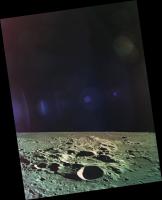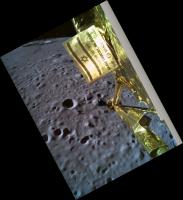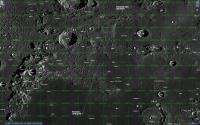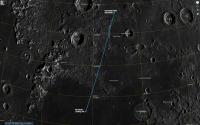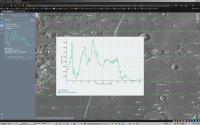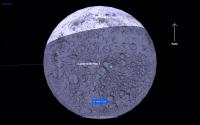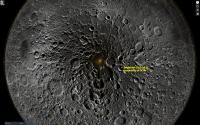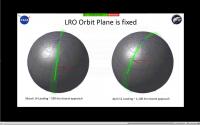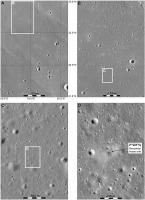Printable Version of Topic
Click here to view this topic in its original format
Unmanned Spaceflight.com _ Lunar Exploration _ SpaceIL lunar lander mission - 2019
Posted by: Phil Stooke Sep 13 2018, 06:21 AM
I'm setting this up in preparation for the launch of SpaceIL's lunar mission, probably early next year. They have arranged a rideshare with Spaceflight Industries on a Falcon 9 launch early in 2019. Earlier they were saying launch in December, land on the Moon in February, so now I assume the landing might be delayed until March. This mission was originally going to be part of the Google Lunar X Prize, but that of course is now gone. It might be rekindled with a different sponsor (though I doubt it).
SpaceIL is the first of the GLXP teams to actually make it to a launch. For what it's worth, I expect Astrobotic to fly as well, and I think Team Indus and PTScientists may also get off the ground. I'm hearing things about Moon Express which cause me to doubt its chances.
More on landing sites shortly.
Phil
Posted by: Phil Stooke Sep 13 2018, 07:09 PM
The lander will carry a magnetometer, and landing site discussions have suggested landing at a magnetic anomaly. Early talk about this suggested landing at the well-known Reiner Gamma swirl and magnetic anomaly in Oceanus Procellarum, probably the best known such feature on the Moon. This was illustrated in a Youtube video:
https://www.youtube.com/watch?v=VRJ5HsgHhxQ
Subsequent work changed the target. Areas within about 20 degrees of the limb were off limits to avoid communication problems, and areas within about --- degrees of the equator were rejected for thermal reasons (to avoid the hottest temperatures at lunar noon). Within the northern and southern zones remaining, topographically safe sites were selected, avoiding regions with particularly low or high albedo to facilitate use of the laser altimeter. Those sites were compared with maps of magnetic anomalies and three potential sites were selected. This process is described in a 2017 LPSC abstract and poster:
LPSC abstract, 2017:
https://www.hou.usra.edu/meetings/lpsc2017/pdf/1914.pdf
associated poster:
https://www.researchgate.net/publication/321587644_Landing_site_selection_for_the_SpaceIL_mission_to_the_Moon
(I spoke to Grossman at the meeting).
The favoured site was near Berzelius crater. I will show a map later.
Phil
Posted by: Phil Stooke Sep 23 2018, 05:49 PM
This illustration shows the sites suggested for SpaceIL in the abstract and poster mentioned above.
The company which built the lander for SpaceIL is contemplating the possibility of future missions:
https://spacenews.com/iai-studying-follow-on-opportunities-for-spaceil-lunar-lander/
Phil
Posted by: nprev Sep 24 2018, 03:48 AM
Interesting. Kinda makes me wonder if they're actually interested in finding ferrous metal deposits, presumably left by iron-nickel impactors.
Posted by: Phil Stooke Oct 30 2018, 11:46 PM
SpaceIL has been running a lander name competition - I didn't know about it, but it looks like it ran on their Facebook page and they got lots of suggestions, then made a shortlist and are now asking the public to vote on names from the shortlist.
https://twitter.com/teamspaceil?lang=en
http://www.spaceil.com/
Phil
Posted by: Phil Stooke Nov 8 2018, 05:13 PM
A very nice update on SpaceIL at the Planetary Society:
http://www.planetary.org/blogs/jason-davis/spaceil-lander-feature.html
In particular it contains details of the landing site, and it is one I had not seen mentioned before. The previous site information which I posted above was from an LPSC presentation, but this is different - the NW edge of Mare Serenitatis. In the earlier work mare areas were ruled out as not suitable for the use of their laser altimeter (too dark, reducing the reflected signal). Back to the (map) drawing board! (or as I call it, the kitchen table).
Phil
EDIT: Oops, here is an earlier statement:
https://www.israel21c.org/israeli-space-team-still-shooting-for-the-moon/
I had seen it but had foolishly discounted it because of the earlier prohibition on dark mare surfaces.
Posted by: Phil Stooke Dec 13 2018, 08:05 AM
Follow-on to the naming story - SpaceIL has just tweeted their name for the lander, which had been called Sparrow since the very beginning. Now it has a new name, Beresheet, meaning 'in the beginning' (or 'Genesis').
Phil
Posted by: Phil Stooke Dec 18 2018, 09:29 PM
This is the new SpaceIL landing area. Launch now set for February 2019 on a rideshare Falcon 9.
Phil
EDIT: updated the map on 19 December
Posted by: SpaceListener Dec 18 2018, 09:41 PM
Phil
[attachment=43905:landing_area.jpg]
How high is the map calibrated? The landing site looks very smooth but it is not true if the picture is not close enough to see better about the roughness of the surface.
Posted by: Phil Stooke Dec 18 2018, 09:48 PM
You are referring to the scale of the map, and as you say, at this scale we don't see small hazards. But we do see large hazards and they are nearly absent from this area. No part of the Moon is really smooth.
Phil
Posted by: SpaceListener Dec 19 2018, 05:33 PM
To refresh news from SpaceIL
http://www.moondaily.com/reports/Israeli_spacecraft_gets_special_passenger_before_moon_journey_999.html
Already very soon, perhaps in two months for the launch.
Posted by: Thorsten Denk Dec 28 2018, 12:19 PM
The date is NET 13-February.
The ride is shared with Indonesia’s PSN-6 communications satellite.
https://www.teslarati.com/spacex-falcon-9-commercial-moon-lander-interplanetary-launch/
The 13-Feb is the date that was originally foreseen as the landing date, with launch in December 2018.
The lunar phase on Feb-13 is 8 days old, this means good timing for an early morning landing.
Of course this will not happen this way because the trip to the Moon also needs a few days.
So I expect the landing at least one month later (mid-March),
or maybe even two if they follow the original flight plan.
Best
Thorsten
PS: EDIT: "with launch in December 2018", not 2017.
Posted by: Thorsten Denk Feb 19 2019, 08:41 AM
Launch of SpaceIL's Beresheet Lunar Lander next Thursday (Friday UTC)!
https://edition.cnn.com/2019/02/18/middleeast/israel-spacecraft-beresheet-launch-intl/index.html
Landing on April 11, this seems less then one day from local sunrise. Interesting!
Thorsten
Posted by: Thorsten Denk Feb 21 2019, 08:26 AM
Somewhere (I don't find it anymore ![]() )
)
I read that April 11 is the date of LOI,
followed by another week of orbiting the Moon.
This would mean landing around local noon,
what makes more sense...
Thorsten
Posted by: Paolo Feb 21 2019, 10:45 AM
there is a good recap of the mission on the Nature website:
https://www.nature.com/articles/d41586-019-00634-8
Posted by: nprev Feb 22 2019, 02:21 AM
SpaceIL has successfully separated from the Falcon 9 upper stage. ![]()
Posted by: Phil Stooke Feb 22 2019, 02:51 AM
This LPSC abstract:
http://www.hou.usra.edu/meetings/lpsc2019/pdf/2290.pdf
provides more detailed information on the landing site.
Phil
Posted by: Thorsten Denk Feb 23 2019, 05:27 PM
On this page https://live.spaceil.com/ there is a simulation of the present position of the probe.
If I calculated well, the LOI is late on April 4 (UTC) and the landing on April 12 at 05:16:17 UTC.
Is there somewhere a more detailed timeline of the mission?
Thorsten
Posted by: SpaceListener Feb 28 2019, 08:22 PM
News from today, the SpaceIL has failed with the starship tracer during a maneuver to direct the ship to the lunar surface.
For more details (in Spanish) https://www.milenio.com/ciencia-y-salud/sonda-israeli-beresheet-falla-viaje-luna
Engineers analyze the problem, but for now, the ship is still working properly and it is going to complete its second Earth's orbit.
Posted by: Explorer1 Feb 28 2019, 08:58 PM
Looks like the maneuver was redone and went fine, apoapse is now 131,000 KM: https://twitter.com/TeamSpaceIL/status/1101222662444072973
Posted by: kenny Mar 20 2019, 11:30 AM
Beresheet has conducted its fourth engine firing, a 60-sec burn, which is the final one before entering lunar orbit on 4 April. Landing due 11 April.
https://www.timesofisrael.com/israeli-spacecraft-performs-final-maneuver-before-moon-landing-bid/
Posted by: SpaceListener Mar 20 2019, 03:19 PM
Now Beresheet is reaching the fourth apogee earth orbit. The next orbit will be the final ones?
Posted by: kenny Mar 20 2019, 07:23 PM
I think it will stay in this Earth orbit, its final one, until its apogee of 4th April coincides with the arrival of the Moon at that point.
It will then fire the engine again on that date and transition into its first lunar orbit.
Posted by: SpaceListener Apr 2 2019, 03:42 PM
The spaceship: Beresheet is about two days away to be inserted into the gravity of the moon. Its orbit looks in a good way to be captured by the moon on this Thursday, April 4.
Posted by: Phil Stooke Apr 4 2019, 12:06 AM
This is the landing area. The 'Aharonson et al. 2019' reference is their LPSC abstract. The enlarged image, an LRO wide-angle mosaic, shows the area of the three sites. They show up as slightly darker areas of the mare surface.
Phil
Posted by: SpaceListener Apr 4 2019, 04:00 PM
The Bereshet was already captured by the Moon's gravity
The time stamp is from CDT
Posted by: Steve G Apr 5 2019, 08:49 PM
A couple of pics from the far side available on IL's Facebook page
https://www.facebook.com/SpaceIL
I can never get bored of pictures of the moon.
Posted by: Explorer1 Apr 11 2019, 07:10 PM
https://www.youtube.com/watch?v=HMdUcchBYRA
Some great live telemetry (though narration mostly in Hebrew)!
Posted by: B Bernatchez Apr 11 2019, 07:13 PM
Any idea when/if LRO will be imaging the landing site?
Posted by: Explorer1 Apr 11 2019, 07:28 PM
Looks like the main engine failed, and they lost contact soon after. Seems like a a hard impact based on the last telemetry.
Space is hard folks....
Posted by: algorithm Apr 11 2019, 07:29 PM
Controlled landing unssucessful, main engine failure, fantastic effort from a non govenmental enterprise.
Posted by: Hungry4info Apr 11 2019, 08:02 PM
From https://twitter.com/EladRatson/status/1116427960033136640/photo/1 tweet.
Posted by: Thorsten Denk Apr 11 2019, 09:25 PM
Just wondering if Phil Stooke will identify the craters... ![]()
Thorsten
Posted by: marsbug Apr 11 2019, 10:05 PM
Well done to them - as I understand it this was far more a mission about promoting STEM education, PR, and inspiring people than it was about science. They've achieved 99% of what they hoped for just by making it into lunar orbit, so well done - even a hard lunar landing is a huge achievement.
That said, I'm seriously hoping that 'inspiring people' part means we can look forward to some new (hopefully not 150 meters/sec) private landing attempts in the not too distant future......
Posted by: Explorer1 Apr 11 2019, 10:14 PM
Yeah, Phil will definitely identify the craters!
That IMU issue and premature engine cutoff reminds me of Schiaparelli's impact (in trajectory if not in exact cause). Hopefully LRO can take a look during this lunar day or the next.
My hats off to the team; an incredible achievement, and apparently they still win the million dollars for the X-Prize contest (no other team even got to launch!)
Posted by: Thorsten Denk Apr 11 2019, 10:32 PM
The crater should be Hypatia A.
looking North East into Mare Tranquilitatis.
Still over 1000km from the landing point.
(Credits for identification go to @Henning81 from the German astronomie.de)
Thorsten
Posted by: Phil Stooke Apr 11 2019, 11:41 PM
Here's the first image, reprojected a bit to help identify it ...
The crater near the limb is Burg in Lacus Mortis, 45 north, 28 east.
That's a bit off the landing longitude. Was it from a previous orbit?
Phil
Posted by: Phil Stooke Apr 11 2019, 11:49 PM
And the second. As was said already, it's Hypatia at 4 south, 22 east. Looking northeast from one of the four side-mounted cameras which would have taken the surface panorama.
Far south of the landing site, so although just released, presumably it must be from an earlier orbit.
Phil
Posted by: JRehling Apr 12 2019, 01:26 AM
I have to say, it somewhat alarmed me to see that photo and identify it as the spur of highlands south of the Apollo 11 landing site. It's the feature I use as a finder to zero in on that location. I'm sure I don't know the entire Moon that well, but that's one spot that I do.
Posted by: John Whitehead Apr 12 2019, 05:59 AM
On April 5, Space News reported that the lander fired its main engine for six minutes, slowing the spacecraft by about 1,000 kilometers per hour.
https://spacenews.com/spaceil-lander-enters-lunar-orbit/
These numbers work out to 0.77 meters per second squared acceleration, which is less than half of lunar surface gravity. Landing from a low lunar orbit needs about half of the spacecraft to be propellant, so after burning that off, the deceleration capability would still be less than lunar surface gravity. So if the reported numbers correctly represent full thrust from the main engine, there would not have been enough thrust to land.
Does anyone know the correct numbers for the orbit insertion burn last week, or is it true that there simply was not enough thrust?
Otherwise, what did I miss in my calculation? A million meters per hour in 6 minutes is 278 m/s in 360 s, or 0.77 m/s^2.
Posted by: Xerxes Apr 12 2019, 02:17 PM
I'm not sure you missed anything. According to the Wikipedia entry, Beresheet has a dry mass of 150kg and a Leros 2b engine capable of 407N thrust. If we assume it's near-dry at landing, that gives it 2.7 m/s^2 acceleration, which should be fine for a lunar landing.
The fueled mass is more like 585kg, of which I think they'd used about 100kg of fuel at that point, which works out to 0.90 m/s^2, perhaps within the uncertainty of our napkin-based calculations. Presumably, the rest of the fuel is used up lowering the apolune and during the descent maneuver, though I haven't been able to find any clear description of the engine firing for those maneuvers.
Posted by: Paolo Apr 13 2019, 06:46 AM
any idea whether the expected magnetometer data to be collected during orbits and descent have been obtained?
Posted by: Phil Stooke Apr 13 2019, 06:43 PM
News today:
Leonard David reports LRO's LOLA laser will attempt to get a reflection from the ball-shaped reflector, if it survived the crash.
http://www.leonarddavid.com/did-nasa-experiment-survive-on-failed-israel-moon-lander/
No word yet on if any magnetometer results were transmitted.
Kahn will begin a Beresheet 2 mission right away. Flight in 2 or 3 years.
https://www.timesofisrael.com/spaceil-chief-beresheet-2-starts-tomorrow-well-put-our-flag-on-the-moon/
Phil
Posted by: GoneToPlaid Apr 14 2019, 03:48 AM
LIVE BROADCAST URL:
https://www.youtube.com/watch?v=HMdUcchBYRA
This undated image was shown at 18:35 in the recorded live broadcast. Phil and Thorsten have correctly identified the lunar location as Hypatia A.
The Beresheet selfie photo was shown at 31:33 during the live broadcast. Further work shows that it could not have been taken during the descent.
Following is a listing of the events which I observed while reviewing the live broadcast video.
All times, below, are video recording time stamps.
18:35 A photo taken at an unknown time and lunar location is shown during the live broadcast.
Up until the following video time stamps, neither the telemetry indicator nor the horizontal velocity value is green. Altitude and vertical velocity are shown in yellow.
23:03 Telemetry indicator turns green. Sub State is Orientation.
25:04 Sub State changes to Braking.
25:20 "We are past the point of no return."
25:26 The Point of No Return indicator turns black.
25:52 Vertical velocity display turns green.
28:16 Telemetry indicator is no longer green.
28:20 Telemetry indicator momentarily turns green, then is no longer green.
29.37 Distance is shown as 210 km.
29:50 Distance changes to 385 km.
30:03 Distance changes to 370 km.
30:40 Telemetry indicator is green.
30:51 Distance is 314 km.
31:33 Beresheet selfie is shown. Altitude approx 22 km??? Telemetry is green.
31:50 Telemetry indicator is no longer green.
31:55 to 32:29 "[inaudible] kill it." "[More inaudible mission chatter] busy."
32:48 Telemetry screen is shown. Telemetry indicator is light yellow. Altitude is 14095 m. Horizontal velocity is 955.5 m/s. Vertical velocity is 24.8 m/s. Main engine is on. Horizontal velocity is light yellow. Other parameters are green, except for the telemetry indicator.
32:49 All engines are on.
32:51 All engines are off.
32:55 Main engine is on.
32:57 All engines are on.
32:59 Main engine is on. Distance is 183.8 km.
33:01 - 33:03 "IMUstein not okay."
33:02 All engines are on.
33:05 Main engine is on.
33:07 All engines are on.
33:09 Main engine is on.
33:11 All engines are on.
33:13 Main engine is on.
33:16 All engines are on.
33:20 Telemetry indicator turns green. All engines are off. All displays remain static (no change).
33:32 Telemetry indicator is no longer green. All engines are off. All displays remain static (no change).
34:24 Telemetry indicator turns green. All engines are off, yet supposedly turn on. Vertical acceleration on the Z axis is fixed at 0.6. "We currently have a problem in one of our inertial measurement units." Vertical velocity starts to steadily increase. Altitude continues to steadily decrease. Vertical acceleration on the Z axis becomes fixed at 0.6. Main engine probably is not on.
Telemetry indicator intermittently turns green and then turns light yellow, up until the following video time stamp.
34:56 Telemetry indicator is no longer green. Although all engines are shown as on, vertical velocity continues to increase. Vertical acceleration on the Z axis remains fixed at 0.6. Main engine probably is not on.
36:25 - 36:33 "We seem to have a problem with our main engine. We are resetting the spacecraft to try to enable the engine."
36:40 Telemetry indicator is green. All engines appear to be on, yet Z axis acceleration remains fixed at 0.6 m/s. Altitude is 678 meters. Horizontal and vertical velocities are 948.1 m/s and 130.1 m/s respectively.
36:44 Last telemetry data. Telemetry indicator is green. All engines appear to be on. Z axis acceleration changes to 0.7 m/s. Final altitude is 149 meters. Final horizontal and vertical velocities are 946.7 and 134.3 m/s respectively. Main engine does not appear to be functioning properly.
Posted by: GoneToPlaid Apr 14 2019, 04:07 AM
Hypatia A
Here is a LRO QuickMap link to match the Beresheet photo:
http://bit.ly/2P984hh
And attached is the correctly orientated Beresheet photo.
Posted by: GoneToPlaid Apr 14 2019, 04:12 AM
Beresheet's last photo...
My correctly orientated and enhanced version of Beresheet's last published selfie photo is attached. The large crater seen in the distance (top and to the left of the flag) is Burg.
Here is a LRO QuickMap 3D link for the photo:
http://bit.ly/2P5MQkj
Posted by: GoneToPlaid Apr 14 2019, 04:31 AM
[attachment=44600:Bereshee...QuickMap.jpg]LRO QuickMap 2D and 3D screen captures, and QuickMap links for the screen captures...BERESHEET FLIGHT PATH FROM SELFIE TO PLANNED LANDING SITE (2D):
This is NOT the correct flight path. I assumed that the selfie photo shown live was taken either just before or during descent:
http://bit.ly/2PbqspxBERESHEET FLIGHT PATH FROM SELFIE TO PLANNED LANDING SITE (3D):
This is NOT the correct flight path. I assumed that the selfie photo shown live was taken either just before or during descent:
http://bit.ly/2P7DIvw
Posted by: GoneToPlaid Apr 14 2019, 04:33 AM
The terrain from Beresheet's last selfie photo and the intended landing site...
This is not the correct flight path for the descent.
Posted by: Phil Stooke Apr 15 2019, 03:44 AM
"https://www.reddit.com/r/space/comments/bd34il/hi_my_name_is_ben_nathaniel_i_work_on_the_team_of/"
Reddit has this 'ask me anything' with a spaceIL team member. Among other things it confirms that the Hypatia image was taken 4 hours before the landing attempt (2 orbits earlier). I suspect that the Lacus Mortis image was taken on that orbit or the next. I don't think it can be from the descent, so I don't think a path can be mapped from the image location to the landing site. The time of image release is not indicative of when it was taken. The Reddit does say that there is another image not yet released, possibly from the actual descent. It also appears that there is some magnetometer data taken and probably on the ground.
Phil
Posted by: Thorsten Denk Apr 15 2019, 06:50 AM
Just two questions:
Was the (final) orbit perfectly polar, meaning inclination 90°? Or somewhat less?
And: Was the spacecraft flying south->north or north->south when at the near side?
I haven't read anything about this until now...
Thorsten
Posted by: Phil Stooke Apr 15 2019, 04:34 PM
See the LRO presentation at LEAG last year linked near the bottom of this page:
https://www.hou.usra.edu/meetings/leag2018/program/Agenda_Recordings.pdf
(you need Adobe Connect to view it, as unfortunately LEAG only archived the video presentation rather than the PDF of the slides. I would prefer both)
The discussion illustrates the geometry of LRO observations of the actual landing with one modelled date in April. Bottom line, no direct observation possible, but the Beresheet orbit is shown as nearly polar and north to south on approach.
Phil
Posted by: GoneToPlaid Apr 15 2019, 06:19 PM
Reddit has this 'ask me anything' with a spaceIL team member. Among other things it confirms that the Hypatia image was taken 4 hours before the landing attempt (2 orbits earlier). I suspect that the Lacus Mortis image was taken on that orbit or the next. I don't think it can be from the descent, so I don't think a path can be mapped from the image location to the landing site. The time of image release is not indicative of when it was taken. The Reddit does say that there is another image not yet released, possibly from the actual descent. It also appears that there is some magnetometer data taken and probably on the ground.
Phil
I agree. I found Beresheet's orbit telemetry which was updated up to the point where Beresheet flew over the lunar north polar area on April 11, before the descent sequence started. Here is the link (browser OpenGL support required to view the animation):
https://live.spaceil.com/
When you play the simulation, the simulation at the end stops on April 11. It is also obvious that Beresheet was west of the lunar north pole on April 11 when it came into view from Earth. Given that Beresheet's polar orbit passes approximately 8 degrees west of the lunar north pole as seen from Earth, there is no way that the selfie shown during the live broadcast could have been later than the photo of Hypatia which was shown earlier during the live broadcast. Thus it seems that the selfie photo shown live must have been taken at least a few to several orbits before the Hypatia image was taken.
I don't know why SpaceIL chose to show these two photos during the live broadcast since everyone assumed that these photos were live from the spacecraft, in particular, the selfie photo.
Posted by: GoneToPlaid Apr 15 2019, 06:51 PM
https://www.hou.usra.edu/meetings/leag2018/program/Agenda_Recordings.pdf
(you need Adobe Connect to view it, as unfortunately LEAG only archived the video presentation rather than the PDF of the slides. I would prefer both)
The discussion illustrates the geometry of LRO observations of the actual landing with one modelled date in April. Bottom line, no direct observation possible, but the Beresheet orbit is shown as nearly polar and north to south on approach.
Phil
Hi Phil,
Is the attached image the one you are talking about? I think that the orbits shown in green are the number of LRO orbits which, with off-axis slews, could image Beresheet's landing site if the LRO was in the correct position at the time for the proposed March 14 or April 12 landings. In the right image for April 12, the black line points towards Beresheet's primary landing site (plotted with both a red and black dot), and the red line points towards the alternate primary landing site plotted with a red dot. The other two backup landing sites in the southern hemisphere are also plotted with red dots. Thus the green orbits are not for Beresheet, but instead are for the LRO. At least this is the way that I am interpreting the images for the two dates.
Posted by: Phil Stooke Apr 15 2019, 10:56 PM
You are right! I had mis-remembered that presentation. I was thinking it showed the Beresheet trajectory as well. I am sure I saw it somewhere but now I can't recall where it was. Serves me right for not checking the video before posting. Sorry about that.
Phil
Posted by: Thorsten Denk Apr 17 2019, 02:48 PM
There is a new "final picture" from Beresheet! ![]()
https://twitter.com/saetur/status/1118516159626784769

Thorsten
Posted by: Explorer1 Apr 17 2019, 07:18 PM
From their Twitter feed: "Here are the findings of the preliminary investigation of #Beresheet’s landing maneuver: It appears that during the landing process a command was entered that led to a chain reaction, which caused the main engine to switch off and prevented it from being reactivated."
Final report in a few weeks.
Posted by: charborob May 15 2019, 02:35 PM
http://www.lroc.asu.edu/posts/1101
Posted by: Phil Stooke May 15 2019, 05:52 PM
Yes indeed! Here's a finder map for the crash site.
And a broader view. I had assumed that 'Posidonius 1' was the primary site but maybe that's not correct. At any rate the impact occurred in their site 3. Note that a delay in landing would move the descent trajectory to the west, so the other sites could have functioned as targets for delayed landings.
Phil
Posted by: Thorsten Denk Jun 27 2019, 11:05 AM
Seems there will be no Beresheet-2 on the Moon. ![]()
http://www.parabolicarc.com/2019/06/26/crashed-spaceil-wont-return-moon-beresheet-2/
Thorsten
Posted by: JRehling Aug 10 2019, 01:17 AM
It turns out this crash may have added some tardigrades to the Moon.
https://blogs.scientificamerican.com/life-unbounded/tardigrades-were-already-on-the-moon/
Posted by: Phil Stooke Aug 10 2019, 06:00 AM
There has been a lot of chatter about tardigrades surviving UV radiation and vacuum, but I am not at all sure about them surviving the temperature extremes.
Phil
Posted by: marsbug Aug 11 2019, 11:08 AM
From what I read they can, in their hibernated ptotective state, survive lows of - 200 celcius and highs of +145. It's not clear if they were in that state during the crash, or how their tolerance holds up under the assault of the combined factors of the lunar surface. Even in the best case for them, they might stay viable for a while in some buried-by-the-impact nook with lower than average (for that lattitude) temperature swings and some shelter from other factors, but eventually the lunar conditions will get them, as the cannot leave their protective state without dying. I got the temperature tolerance infofrom here' https://www.livescience.com/57985-tardigrade-facts.html. Are webutting up against rule 1.3 here?
Posted by: Explorer1 Aug 11 2019, 03:26 PM
1.3 says nothing whatsoever about Earth life. Chang'e 4's biological payload and images in the other thread were discussed without issue.
The only terrestrial species we can't discuss on this forum is homo sapiens, obviously (via Rule 1.6)
Posted by: marsbug Aug 11 2019, 04:45 PM
Ok, hang on: The tardigrades are.in their 'safed' hibernating state, and are not exposed to the lunar environmen, but sealed in layers of epoxy resin, sandwiched between layers of nickel, in an object about the size of a coin. The object is itself expected to have survived impact mostly intact. That bodes much better for their odds of long term survival and eventual recovery: A Wired article on the subject https://www.wired.com/story/a-crashed-israeli-lunar-lander-spilled-tardigrades-on-the-moon/:
I can increase the reporyed range of temperature tolerance too, down to pretty much absolute zero, according to this bbc report: http://www.bbc.co.uk/earth/story/20150313-the-toughest-animals-on-earth
Interestingly, in this state, tardigrafes do metabolise albeit at 0.01% their normal rate, and so might be argued to be 'alive' on the lunar surface. But I will say that, if I had to find an extant living thing on the lunar surface today, my 'least hugely unlikely' choice would still be to look in the mini greenhouse on the Chang'e 4 lander, assuming it still has pressure - I would bet some extremophile capable of handling the temperature swings (which would be somewhat moderated by the measures taken to keep the lander functioning) might have snuck in and be surviving off the remains of the dead plants. Ok, sorry for the lurch off topic, I'll leave it thete as a faintly amusing thought.
Posted by: JRehling Aug 11 2019, 05:01 PM
It seems like a decent future mission would be to go grab these and return them to Earth and establish that they remained viable on the Moon. They won't really have been exposed to the full lunar environment (certainly no UV getting through to them) so the odds are good.
From the telemetry, this was more of a hard landing than an impact so the craft is maybe fairly intact.
Of course, it'd be far easier to have a future return craft carry its own tardigrades (etc?) and eliminate the complicated hardware.
Of course, part two: The interplanetary space between the Earth and the Moon already has basically the same environment as the Moon. Landing on the lunar surface only changes the thermal + radiative factors a bit.
Posted by: Thorsten Denk Aug 11 2019, 07:45 PM
Ehem, you think 1km/s impacts are survivable?
Asking for both, the craft and the tardigrades...
Thorsten
Posted by: marsbug Aug 11 2019, 08:08 PM
It's not my field so I cannot vouch for it, but from what was said by this source.... https://amp.businessinsider.com/tardigrades-on-moon-spacecraft-beresheet-likely-still-alive-2019-89-8
"Tardigrades in dry state can survive pressures up to 74,000 times the pressure we experience at sea level, so the [crash] impact should not be a problem for them," evolutionary zoologist Roberto Guidetti told Business Insider.
As for the vehicle... the retro reflector experiment, a small simple chunk of solid material, is thought to have perhaps survived. So I imagine that other components that are also small and basically solid chunks of material, could have survived. So not the vehicle, but identifiable components of it, perhaps, based on my layman reading of what is being said by engineers on the subject.
Posted by: Phil Stooke Aug 26 2019, 09:54 PM
I don't have the time or the desire to investigate tardigrade survival, but I get a sense that there is a bit of tardigrade worship going on around this story, and I am not referring to UMSF here but in the wider media. People are taking it rather for granted that they can survive mind-boggling temperature extremes. All I have done so far is look at the Wikipedia page on tardigrades, and it says that the wee critters can survive temperatures close to absolute zero or up to about 150 C, with citations I have not followed up on. However, the caveat is that they are apparently shown to survive these extremes for 'a few minutes'. The lunar night is not 1 K, but it is a lot longer than a few minutes, and the day would get hotter than 150 C for long periods. I don't think the radiation story is as clear-cut as is sometimes claimed either, particularly if we bring in cosmic rays. Mark me down as skeptical that our little friends have much chance of surviving prolonged exposure to the lunar environment.
Phil
Posted by: JRehling Aug 27 2019, 04:24 AM
Near absolute zero, aren't a few minutes and a billion years about the same thing? Extreme cold is the cessation of change, so it seems like anything that would survive (remain viable) a few minutes of it (if the cold is allowed to penetrate all the way through) would survive an arbitrary duration of it.
It seems like it's the freezing and the unfreezing that would do the harm, not the being-at a low temperature.
PS: Though maybe cosmic ray strikes accumulating for a long time, which are not verboten at low temperatures, would fiddle with biology catastrophically.
Posted by: marsbug Aug 27 2019, 03:12 PM
This is soooo not my area of expertise, but a wee bit of googleing suggests that the lunar regolith has impressive insulating properties, and within half a meter of the surface the temperature is fairly constant at roughly -130 deg C to -150 deg c (eg, here: https://www.sciencedirect.com/science/article/pii/S0094576514004160) even at noon and midnight. Given that something hitting at approx 1km/sec will either smash to bits if it hits stone, or deeply bury if it hits deep, more yielding, regolith (and the lunar surface has little that isn't one or t' other)…. I'd (very tentatively) suggest that the much worshipped tardigrades are either slam dunk dead or in a situation where the effects of low temperature and radiation dmage accumulation on their survival are more likely relevant than the effects of high temperature.
Posted by: nprev Aug 28 2019, 01:05 AM
Might be time to stop beating a dead tardigrade here. (Well...lots of 'em). ![]()
Posted by: marsbug Aug 30 2019, 10:30 AM
I've just started teacher training (physics), and part of it is to teach general science - so we have to get some training in biology. We just did the segment on using microscopes to examine algae and protozoa - we found a tardigrade in our sample. Looking at it it's hard to imagine it's relative made that journey (dead or alive). Not really relevant, but it was very cool and gives me a cool connection to show students how different fields of science can be connected.
Posted by: Phil Stooke Jan 31 2020, 08:55 PM
The LPSC 2020 abstracts are available now (Jan. 31), and one concerns Beresheet. Its magnetometer was used through about half an orbit (perhaps more, but a half-orbit arc is shown), over the Earth-facing side of the Moon prior to the landing attempt. I think the abstract is saying that the data are compromised by the magnetic field of the spacecraft and will not be useful.
Phil
https://www.hou.usra.edu/meetings/lpsc2020/pdf/1267.pdf
Posted by: Explorer1 Jan 31 2020, 09:43 PM
So even if landing was successful, there would not have been useful science regarding the swirls? Talk about sour grapes....
Powered by Invision Power Board (http://www.invisionboard.com)
© Invision Power Services (http://www.invisionpower.com)
